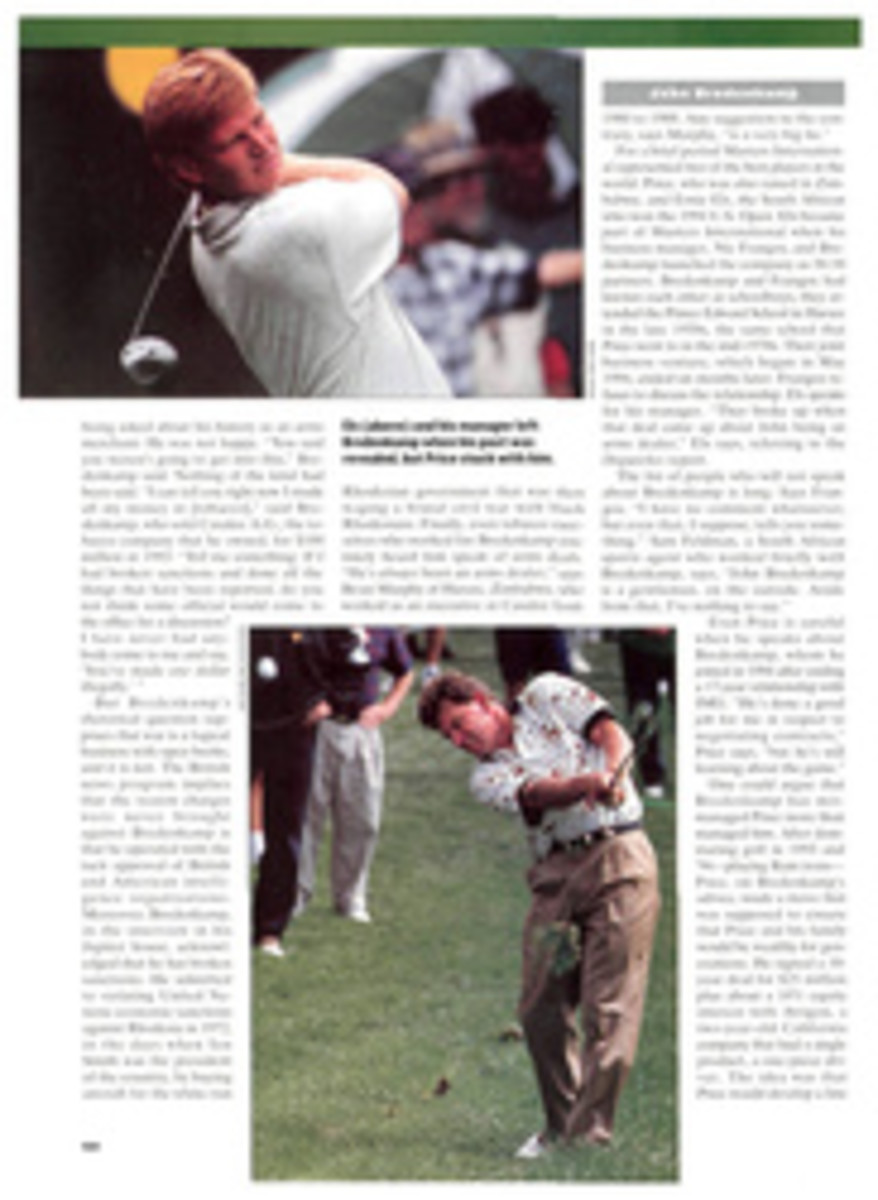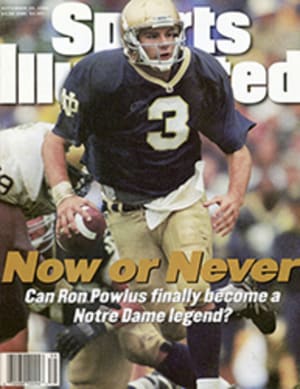
NO PAIN, NO GAIN IN ONLY HIS THIRD START AS A PRO, TIGER WOODS LEARNED A BITTER LESSON ABOUT LIFE ON TOUR
Tiger Woods has spoiled us. Five months ago he said his goals
were to win the NCAA Championship and an unprecedented third
straight U.S. Amateur, and he accomplished both. After turning
pro, he said he aimed to win enough money in only seven
tournaments to secure his PGA Tour card. At first we were
dubious, but then he played with such power and poise that his
plan seemed more modest than unreasonable. Now when he says he
intends to win a Tour event, as he did last week on the eve of
the Quad City Classic in Coal Valley, Ill., we take him at his
word. So when Woods shot a second-round 64 that included six
straight birdies to take the lead at Oakwood Country Club and
held steady with a third-round 67, a good portion of the golf
world, and almost all the other people who don't care about the
game but are crazy about Tiger, believed the 20-year-old would
take another giant step.
There were some valid statistical reasons to bank on Woods on
Sunday, such as the eye-popping 312.5-yard driving average and
the gaudy 68.5 stroke average from his first 10 rounds as a pro.
But mostly that belief was based on empirical evidence. Woods
has demonstrated a genius for getting the job done, closing the
deal. "Let the legend grow"--the seductive mantra of his father,
Earl Woods, who has never been surprised by his son's
accomplishments--has become a subliminal battle cry for Tiger.
But in Sunday's final round, the game answered back. Golf
inflicts pain on those who play it, and there are no exceptions.
Ben Crenshaw and Jack Nicklaus, whose early careers parallel
Woods's, absorbed a Tour bagful of psychic harpoons early on,
with Nicklaus's tough hide proving an indispensible part of his
greatness. Woods might be made of similar stuff, but the
definitive tests have yet to be conducted. Sunday's ordeal (he
closed with a two-over-par 72 to finish tied for fifth at eight
under, four strokes behind winner Ed Fiori) can be considered
his first pop quiz.
On Sunday, Woods found himself in unknown territory. His young
man's propensity for making the big number, plus an alarming
inability to steady a jumpy putter, cost him a tournament he
knows he could have won with even an average performance. As
Woods licked his wounds, the legend went into remission. After
starting the day with a 337-yard drive down the middle of the
1st fairway, Woods birdied the second hole, and as he stood on
the 4th tee, he saw his name atop the leader board with a
three-stroke lead over such unimposing pros as Jay Delsing, Phil
Blackmar and Fiori, with whom he was paired. But playing for a
fade off the tee on the 460-yard 4th, a hole that doglegs to the
right, Woods rushed his downswing and hit a double cross he's
likely to remember. His ball flew left over trees and into a
pond. As Woods said later, "From there, the adventure began."
Woods had to take a penalty drop on a steep embankment in heavy
rough that left him the option of chipping back to the fairway
or trying to reach the green, some 200 yards away, by blasting
an iron through an opening in the trees that was about the size
of a doorway. He chose poorly, deciding to go for the green.
Woods pushed his six-iron shot, and the ball caromed dead left
off an oak limb, disappearing into the bright green algae of the
hazard. Another penalty, a chip out, an approach and two putts
later, Woods had completed a quadruple-bogey 8.
Trailing by a stroke and suddenly looking very young, Woods
rallied to par the 5th and birdie the par-5 6th. But when it
appeared that he might be summoning a comeback of U.S. Amateur
proportions, Woods somehow four-jacked the relatively flat 7th
green from the astonishing distance of eight feet. Woods pulled
his birdie try four feet by, jabbed the comebacker the same
distance in the other direction and barely grazed the left lip
with his third putt. He finally sank a three-footer for
double-bogey 6. Quad City, indeed.
The wreck was more shocking than the nine strokes Woods lost to
par over the final five holes of the opening round at the U.S.
Open at Oakland Hills, after he was tied for the lead. "I was
shocked," said Earl Woods, finally admitting surprise. "I
thought that reaction would be all over with after the U.S.
Open. But that was a first round. This was a final round. It's a
new, valuable lesson."
Playing through his disappointment, Woods dug deep for four more
birdies that salvaged a tie for fifth, but a golden opportunity
had slipped away. Woods was the only player among the top 18
finishers to shoot higher than 69 on Sunday. At crunch time he
had been crunched by a field weakened by the Presidents Cup.
After signing his scorecard, Woods was embraced by his coach,
Butch Harmon, and for a moment fought back tears. "The one thing
he is going to learn from this is how hard it is to win a Tour
event," says Harmon, who had to be taken to the hospital on
Saturday after inadvertently swallowing a bee. "The way things
were going, I don't think he thought it was too hard."
He knows now. Quad City was perhaps the first real setback in
Woods's heretofore charmed career. If Woods wasn't convinced
that pain is the rule rather than the exception on the PGA Tour,
he had to look no further than the winner, Fiori, whose career
has run aground on several occasions. Known as the Grip because
of the extreme palm-down position of his left hand on the club,
the 43-year-old Fiori is the anti-Tiger--a squat, bullnecked
grinder and one of the shortest hitters on the Tour. He is
playing this year on a medical extension for a rotator-cuff
injury and before Quad City had earned far less than the $62,507
he needed to keep his card in 1997. He had already sent in his
application for the next Q school and had told his wife and two
children he would probably become a charter-boat captain near
his home outside Houston if he didn't make it. Until now, Fiori
hasn't been in the top 100 on the money list since 1989. His
victory came 14 years and seven months after his last one, in
the 1982 Bob Hope Desert Classic, the second-longest span
between wins in the history of the Tour.
In 14 years Woods might look back fondly on the Quad City
Classic. He did many things well. On a day in which he had two
penalty strokes and a four-putt, he battled back with six
birdies to finish with a respectable score. In righting himself
when all hope of victory was lost, he did the professional
thing, winning a nice check. He has four tournaments to avoid a
trip to Q school, where the hurt can be permanent.
"I see progress," Woods says. "I keep getting better. It's hard
to say right now what I learned. I'll know better in a couple of
days. I will tell you one thing: I will learn a lot from this."
The foremost lesson might be one that will be reinforced over
and over in the years to come: no pain, no gain.
COLOR PHOTO: PHOTOGRAPHS BY DAVID WALBERG [Tiger Woods]
COLOR PHOTO: PHOTOGRAPHS BY DAVID WALBERG Sunday school began on the 4th hole, where Woods was taught that it's difficult to recover from an 8. [Tiger Woods]
TIGER'S HALFWAY HOME
After his tie for fifth in the Quad City Classic, Tiger Woods
has won more than half of the money he needs to secure a 1997
Tour card. Woods plans to play in four more events and must earn
about $150,000 total to finish 125th or better on the money list
and win his card. Finishing 126th to 150th would be almost as
good, making him eligible for an unlimited number of sponsors'
exemptions in '97 and exempt from all but the final stage of the
three-tournament Q school. Last year 150th place was $113,632.
Here's how Woods stands after three events.
EVENT PLACE MONEY RANK
Milwaukee T60 $2,544 346
Canadian 11 $37,500 204
Quad City T5 $42,150 166
TOTAL $82,194
Ahead: B.C. Open (Sept. 19-22), Buick (Sept. 26-29), Las Vegas
(Oct. 2-6), Texas (Oct. 10-13).

